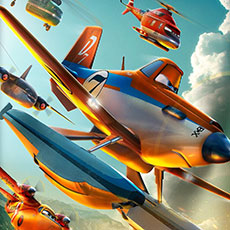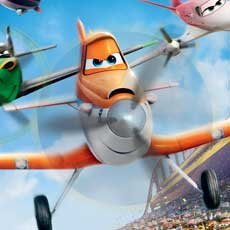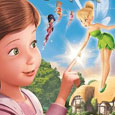DisneyToon Studios (2014), Walt Disney Home Entertainment (November 4 2014), Blu-ray and DVD Combo Pack, 84 mins plus supplements, 1080p high-definition 2.39:1 widescreen, DTS-HD 7.1 Master Audio, Rated PG, Retail: $39.99
Storyboard:
Having conquered the world of air racing, crop-duster plane Dusty joins up with a bunch of veteran firefighters to save Piston Peak National Park from raging wildfires.
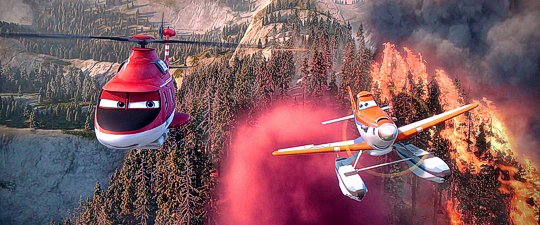
The Sweatbox Review:
I’ve said it before and no doubt I’ll say it again when the inevitable third entries in the Cars and Planes franchise come along: I don’t “get” the Cars world – it just doesn’t make sense! In a magical way, the likes of Little Toot and Susie, The Little Blue Coupe – classic cartoons of their kind from the golden age of animation – work because we know they’re anthropomorphized characters based on real inanimate objects, just like Woody and Buzz in Toy Story or, to use a more related example, Herbie the Volkswagen in the Love Bug movies. These characters all live in our world, possessing characteristics that we know can’t be real in any logical sense but tap into our imaginations (and sometimes a persistent feeling that your car, computer or soft toy must be “alive” in some sense!) to make them “real”.
However, in Cars world – which I really think should just be called “Vehicles” since, with the subsequent introduction of Planes and the many other boats and trains seen in the films, we’ve long passed the suggestion that the automobiles are on their own – there is no such explanation. Here, in the original Cars, they just exist, without any say so on how or why. Now, I’m not bereft of any imagination myself, and I’m not the kind of person that needs a logical explanation for everything – goodness knows half the movies I watch would fall apart on any closer such inspection – but too many questions of Cars remain on a fundamental level, all of which I’ve posed in previous reviews.
With each new film, answers have not been forthcoming, and in fact the international globe-trotting Cars 2 only raised more! Yes, we can simply choose to ignore the basics (such as who built these vehicles, and how, or why do they have seats for the non-existent humans?) and just try to accept this world as is, but here the usually wonderful filmmakers at Pixar keep missing the tiny details or stray from their own established rules simply to play to a gag, include a certain kind of situation or a need to cover a story point. Now all of this is totally inconsequential to a seven year old boy, the likes of whom the Cars franchise is just a way to mix two things they love – toy cars and movies – together and probably provide a stimulus for their own adventures with the films’ cast in their own back yard.
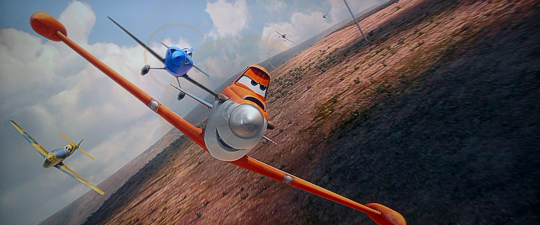
It was with this in mind that I attempted to approach the first Planes, originally intended as a direct-to-video spin-off from Cars that would bring the boy demographic to that department of the Disney empire after their series of Tinker Bell films proved so popular with young girls. Not actually produced by Pixar but by the DisneyToon Studio, Planes was nonetheless a Pixar Cars franchise entry in all but name, sharing the same world, similar if not the same supporting kinds of cars, and an executive producer in Cars’ director John Lasseter. It was, I suspect, a shrewd move on Pixar’s part: somewhat criticized for the Cars sequel that was almost admittedly made because the toys were so successful, the company may have been reticent to become known as a franchise sequel machine, especially after their top brass so openly criticized Disney’s now ended DTV “cheapquel” operation, and so a Cars-branded spin-off – but without the Pixar logo attached – made for the best of both worlds.
Had Planes failed, it would have been Disney that took the heat, and so still protecting the Cars name that will indeed see its third entry emerge in a couple of years’ time. In the meantime, Planes fills the gap left open by the seemingly ended run of Cars Toons, switching the focus to a new set of vehicles that makes for a nice new line of merchandise. Call me cynical, but I suspect this is the real reason these films don’t reach the great heights of Disney and Pixar’s past: they’re not being made for the right motive and, perhaps, the filmmakers’ hearts are not fully into the projects at hand. It’s not easy to make a great film (luck has more than a fair share in it!), but it is relatively so to pull together a so-so 90 minute commercial that showcases a new bunch of characters that the target audience can go out and buy as toys right after seeing the movie.
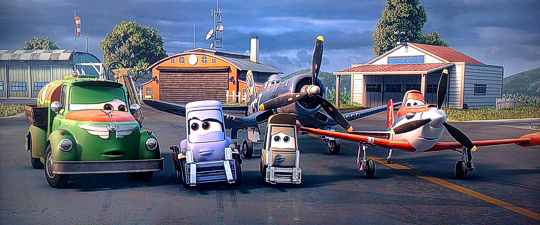
As I said, I did try to put all of this out of mind when sitting to view the first Planes… As with the first Cars, and especially its much more fun (in concept) sequel, I really wanted to like the idea, and really wanted to plug in to my memories of Susie, The Little Blue Coupe and, especially the story of the plucky little plane Pedro from Saludos Amigos, and just try and get a sense of the fun of things. But the first Planes really wasn’t that great: switching the project from DTV status to a theatrical summer release enabled the animators to “go large” with things, and the 3D aspect they’d trialled with a previous Tinker Bell movie, Secret Of The Wings, came in handy in presenting the film as a bigger event that it might have first appeared, but if story is king, as they say, then this was a lowly court jester.
Essentially rehashing the underdog tale of the first Cars, the initial Planes movie didn’t succeed in being anything more than that. Maybe that was just the point (in terms of toy sales I’m sure it was), but in offering the film in a Disney-branded summer slot and upping the stakes to a theatrical level I’m sure than many were hoping for more than they got. For me personally, I was often bored and depressed at the depths to which it had seemed the state of animation had sunk (this coming around the same time as the somewhat similar Turbo, about a super-charged snail from DreamWorks, also used the same story yet again, mixed in with various Cars type elements). And those pesky questions were raised again: with Cars it had been the one thing not to really bother me, but with Planes I kept coming back to the same thing: just what were these things made of? Where did they find malleable wood and metal that would allow for these vehicles’ mouths to move? Why do they all have teeth!?
I also found it limiting that the designs didn’t allow for the characters to use their wings expressively: we’d already established that whatever they’re made of is fluid, so why not let them use their wings, even just to stretch a little bit? In long sections where our nominal hero Dusty was dabbling in spots of “plot” exposition, I found it frustrating just how limited in movement the characters were, which didn’t help my attempts at relating to them. Susie, Little Toot and Pedro work because they’re animated cartoons: here the all-too photo-real and shiny CGI approach actually sucks the life out of these characters, making them rigid and largely abandoning the very basics of animation: that of using it to bring inanimate objects to life with all the squash, stretch and bounce needed to pull off the illusion. Without those elements, Planes becomes a stranger world than Cars, filled with characters who are only half alive: conscious beings, naturally, but with largely paralyzed bodies unable to physically express themselves fully. Which is kind of the point of making these films, isn’t it?
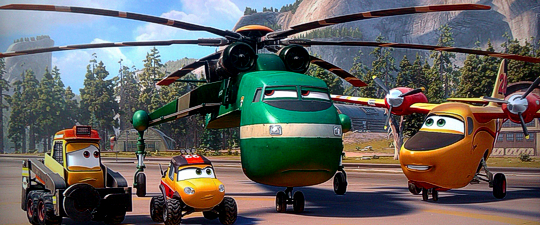
Well, whatever I think and however deep we delve into what works, or doesn’t, and why, the bottom line was that Planes certainly reached its target, and a $130 million-plus take in the US alone meant DisneyToon were given the go ahead to progress with their already on the boards sequel which, wouldntchaknow, introduces a whole new series of toys – oops, sorry – characters, for Dusty to interact with. So, this time out, instead of wanting to go from crop-duster to air champ, the little plane finds himself unable to compete in the big races anymore (for whatever convoluted reasons) but still wants to make a difference and so uses the skills he knows to team up with a series of grizzled veteran firefighter planes to battle wildfires. So far so predictable, you may think, but Planes: Fire & Rescue’s main strong point is that, this time out, the film has been designed as a big screen experience from the start.
Immediately apparent from the opening logos in the wider, near-CinemaScope ratio, Fire & Rescue’s bigger ambitions are signposted on its bigger screen canvas. This is, from what I can recall, a first for DisneyToon Studios, previously the company’s DTV unit who eventually progressed to some terrific traditional animation quality before becoming responsible for the conveyor belt, one-a-year Tinker Bell movies which, to be fair, are still better than the majority of films from other studios. The first Planes felt smaller and more restricted in scope, understandably given its small screen origins, but here the conscious decision to go with the wider frame really does help open up the film and make it feel like a “proper” movie. These visual ambitions are somewhat matched by the unfolding plot, such as it is, which allows for much more interest and involvement from the audience.
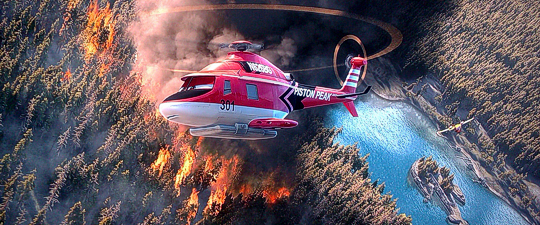
Picking up from the first film, with Dusty now an air-racing champ, a faulty gearbox means he has to drop out from that life, but jumps at the chance when opportunity comes knocking and he has a chance to reinvent himself as a new kind of hero. Venturing to Piston Peak National Park (where the closest we get to seeing nature is a tiny glider plane “feeding” its young!?), Dusty meets a new band of planes at the Air Attack division, where firefighting from the air is the name of the game. The way Dusty leaves his previous life and these introductory scenes are as cookie cutter animation 101 as they come, being near textbook examples of pacing and characterization, but with all this eventually out of the way just after the twenty minute mark, the film finally gets to start to stretch its wings and amongst the otherwise standard montages and character moments, the scenes of forest fires the planes’ attempts to dampen the flames out really are well done.
It’s here where Planes 2 comes alive, even soaring sporadically towards top flight animation filmmaking, mostly due to the jump-cut editing and a terrifically exciting and varied use of camera angles that do their best to help create the motions that the otherwise static characters can only hint at with their eyes and mouths. This is still a problem for this world, and even more so for the planes themselves, where even just a bit of body movement could help make the whole thing feel a little more alive. Otherwise the visual elements are first rate, with a noticeable step up in lighting and shading from the first film and animation streets ahead of what the DisneyTooners have been able to achieve in their Tinker Bell films. Indeed, the opening moments, many of the set-piece sequences and overall production design easily match Pixar in terms of their Cars pictures.

The scripting is a tad more advanced from typical kids’ fare as well (though a “yeah, they’re real” line felt desperately out of place), and a returning cast (including Hal Holbrook and even finding a cameo role for Pixar lucky charm John Ratzenberger) seem to be having fun and provide the continuity between films. I can’t say I was too thrilled with many of the new voices (Ed Harris, John Michael Higgins and the ubiquitous Patrick Warburton among them), who all either simply riff on similar work they’ve already done or sound like characters in other animated films, and I still can’t get to grips with Dane Cook in the lead: he’s seems too assured of himself for the underdog plane that Dusty was in the first film and pretty much gets reset to as part of his joining an established band of pals in which he’s the new guy again. But otherwise it’s business as usual, with the kinds of voices, plot points and gags (“Howard The Truck”!) that again make the Cars films tick over the way they do.
So questions remain (just how can Dusty see the warning light on his own dashboard, and why does he have a dashboard?) and Planes: Fire & Rescue is largely more of the same, but either my expectations have been lowered so much or perhaps I’ve just become numbed to the continued animated vehicle onslaught, but I have to say that – concept frustrations withstanding, formulaic storytelling and predictability issues aside – I did at least find more to enjoy here than I was anticipating. For the target age group, good lessons are imparted, although I do wonder if there’s enough action in the film to keep them engrossed and I wasn’t quite sure at times who that age group was. The Cars/Planes films are the kind of pre-school concept probably best left to animation companies of more limited means, but with Disney-Pixar’s involvement they inevitably play towards older audiences, hence the frustration with their more simplistic approach. This may be a challenge to the artists who make films like these, but for the animated medium, I still just wish the characters were, well, a little bit more…animated!
Is This Thing Loaded?
Disney’s now-standard extras package of behind the scenes featurette, deleted scenes and music clips seems to apply whether a film is a direct-to-video dud or a gigantic-sized theatrical smash, and although not quite as big a hit in theaters as the first film, Planes: Fire & Rescue gets the same treatment as its bigger cousins on disc. First up is “exclusive” new animated short Vitaminamulch Air Spectacular, which somewhat actually undoes the good work the main feature achieves by resorting back to the feel of the earlier film, even losing the wider aspect framing. Just as its parent franchise launched a series of Cars Toons, it seems we could be “treated” to a new run of Planes shorts, although Vitaminamulch plays much more like an extended version of a (possibly deleted) scene from earlier in Fire & Rescue, even if I can appreciate Disney adding value to the set.
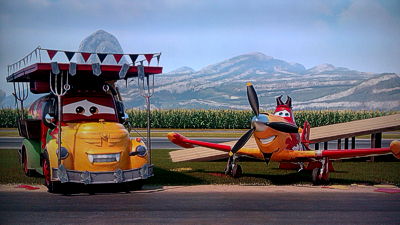
Welcome To Piston Peak isn’t a making of, but a jokey touristy guide to the film’s central locale using Pixar-style postcards and clips from the movie grunged down to home movie like footage and feeling a tad long even at under three minutes. There’s more fakery with a CHoPs TV Promo, playing on the film’s depiction of the Cars world’s version of CHiPS, complete with the original theme music, but it’s over in just 40 seconds.
Air Attack: Firefighters From The Sky is a little more like it: a near five-minute look at real air firefighters (to whom the movie is dedicated) on the job and how the producer and director of the film took inspiration for their story and characters. This is less a behind the scenes look at the film than seeing how the guys prepare for work, but that’s no bad thing and puts the movie in a different kind of context. A bunch of three Deleted Scenes with optional filmmaker introductions don’t really expand on anything significantly, though their extended nature might have filled the final film’s running time out, stretching to 84 minutes as it does with no less than eleven minutes of credits!

The Planes trailers have been ubiquitous on previous Disney discs, but of course there are none to be found on the titles themselves, so providing a modicum of promotional material is a Still I Fly music video that mixes in 90 seconds of movie shots with singer-songwriter Spencer Lee, while rounding out the disc is a collection of two Animated Shorts, Dipper and Smoke Jumpers, which are in reality a couple of slightly bizarre character intro clips that run a minute forty-five each. Notable Sneak Peeks on the disc include the new feature animation Big Hero 6 teaser, the concurrent BD release of Maleficent and the upcoming One Hundred And One Dalmatians (mislabeled as 101 Dalmatians if we’re being purist!) Diamond Edition.
Case Study:
Forgoing the multiple flat and 3D offerings of the first film, Planes 2 arrives on disc in a standard Blu-ray and DVD combo pack, with a 3D option unavailable at this time in the US. Largely replicating the cover art, in initial pressings at least, is a nice slipcover that uses one of the theatrical posters and looks nice and dynamic with an embossed finish. The enclosed DVD features the main feature, naturally, as well as the Vitaminamulch short and music clip.
Ink And Paint:
In terms of home video, 3D seems to have been dying a slow death and even Disney, at one time a huge proponent of the format, has mostly abandoned such releases, at least in the US other than for their Marvel superhero titles where fanboy demand is no doubt a little higher for those wanting to show off their home theater set-ups with the added dimension. In a way, I’m pleased at the choice here: the film is targeted at a demographic whose eyes are still adjusting to the world and while a one-off theatrical experience isn’t going to inhibit this development, there have been warnings against continued use of 3D in the home, especially for young children.

In any event, despite any number of shots where planes could have zoomed in and out at the audience, I found very few moments where any added depth could have really provided anything awesome to the film anyway, and instead found the wider screen and use of color to be much more appealing visually. A huge step-up from the first Planes, Fire & Rescue’s wider framing marks this out as a film to be seen on the big screen from the start, and DisneyToon’s first such outing in this ratio certainly looks the part on this Blu-ray rendering, firmly placing the Planes franchise into the world of Pixar’s Cars in terms of visual tone.
Scratch Tracks:
As enveloping as the wider image is, the sound, even pumping out in full surround mode, fails to reach the same levels, especially in the big moments. If nothing else, Planes: Fire & Rescue is a thrill-ride movie, with much more audience involvement in its perilously dangerous situations than the first, but the soundtrack largely feels uninspired, going through the premium movie-grade motions without ever feeling really involving. If you can see the heat burning off the screen, then you’ll want to hear the flames licking at your speaker set-up, but they’re just not there and, while Mark Mancina’s disappointingly routine score strives to helps elevate the excitement, it’s just too formulaic and derivative that I did wonder if the music had actually been sourced (his Tarzan often came to mind) just as much as the occasional song tracks that pepper the soundtrack. English, French and Spanish dubs and subs are all optional.
Final Cut:
Okay, so the Cars world isn’t aimed at me and I’m not going to suddenly come right out and call this a great movie, or even rest back on the all too lazy suggestion that Planes: Fire & Rescue is good for what it is. It’s simply not top shelf Disney of any vintage, and for older fans of the Studio’s output, struggles to compete with the charm of even the secondary features from the golden age when we first saw anthropomorphic vehicles and planes fill the screen. But…for a younger crowd I can at least see the appeal – wiping away any questions of logic and taking the thing purely at face value – and admit that, just as I felt the Cars Toons format was a better fit for the characters, a change in location and the situations encountered means a bit more excitement takes some of the attention off the less engaging aspects. By no means an essential title for any Disney library, Planes: Fire & Rescue is at least better than the first flight, which may well be faint praise but acknowledges its worth as a well enough made diversion that might, hopefully, inspire some kids to abandon the toys and go on to make something a bit more unique.
 | ||
 |



